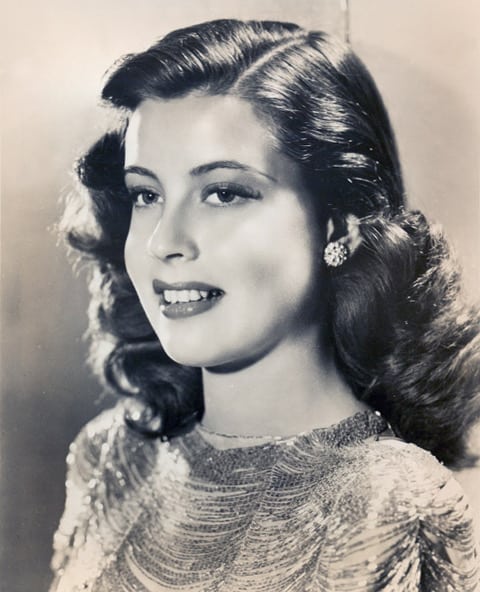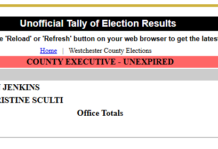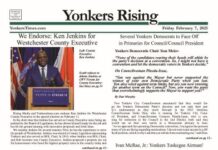
A Yonkers street was named after actrees Gloria De Haven in 1953
By Mary Hoar, City of Yonkers Historian, President Emerita Yonkers Historical Society, recipient of the 2004 Key to History, Member of the Yonkers Landmarks Preservation Board, and President Untermyer Performing Arts Council
Monday, April 10th
April 10, 1942: The US Industrial Chemical Company at the foot of Federal Street played a major part in the War Production Board’s experiment to redistill “high wines” into industrial alcohol. Eleven distilleries sent wine to our plant for processing; the new industrial alcohol would be used to manufacture explosives.
April 10, 1947: The Upper New Main Street Merchants Association suggested the Yonkers Planning Board call the new downtown parking center something other than Chicken Island! They wanted the area called Park Center, saying it was “highly descriptive,” and “would give the district some class.” They proposed roads be cut through so parking would be easily accessible from the entire area.
Tuesday, April 11th
April 11, 1928: Feuding lovers were expelled from the Yonkers Flying Club! After appearing in Court to answer disorderly conduct charges, VP Adam Dengler, Secretary Helen Bailey and Publicity Chair William Bailey were dropped from the organization. Bailey told Judge Boote Dengler took Mrs. Bailey for an airplane ride and never brought her back, adding the duo were living together. Dengler denied the story, stating Bailey was jealous of Helen’s aviation skills.
Club members unanimously decided it was better they were gone.
April 11, 1953: A Yonkers street was named after movie star Gloria De Haven! The planned Adirondack Oval in the Greystone Gardens apartment development instead was named De Haven Drive at the request of developer Martin Kimmel; Kimmel, “a friend” of Ms. De Haven, married the star a few months later.
Wednesday, April 12th
April 12, 1943: After Saunders Trades School was criticized as a “dimout violator,” school officials announced they would create a temporary solution, shades made from wrapping paper. They would use them until the federal government allowed spending $325 for dimout shades. Since the school was used at night for the war training program, the Board of Ed needed to ask the government.
April 12, 1943: After the New York State War Council found “several types of discrimination” in Yonkers war industries, all our firms went “on record as to their willingness to integrate members of minority groups on jobs throughout the plant.” The Council found blanket exclusion of one or more minority groups in some plants; others only hired minority workers for unskilled jobs. A few plants immediately set about changing. The War Council said this was prevalent throughout New York State and promised to closely watch companies not in compliance.
Thursday, April 13th
April 13, 1928: Mayor Thomas Larkin was notified residents of Grey Oaks were filing a lawsuit to prevent installation of an incinerator on Saw Mill River Road, and had the backing of Samuel Untermyer. Untermyer suggested also engaging William Boyce Thompson and the Westchester County Parks Commission; both the Untermyer and Thompson estates extended down into the Nepperhan Valley, and the proposed site was adjacent to the Saw Mill River Parkway being built by Westchester.
April 13, 1938: After an eight-year fight, Cristabel Creswell, finally agreed to move her home from the middle of Railroad Avenue. Creswell had bought her home from the Westchester County Park Commission but had a dispute with the contractor she hired to move it from the parkway’s right of way; he left it right in the middle of the street. For eight years, it stood halfway to its planned location.
Friday, April 14th
April 14, 1933: DPW Commissioner Goldsmith announced the remaining gas lamps on North Broadway would be removed; Besides the 118 lamps still on North Broadway, there were 117 old fashioned streetlamps remaining on Warburton Avenue.
April 14, 1955: After a spirited discussion, the Board of Education passed a resolution to request $33,800 for window shades and drapes in almost every school, by an eight to one vote. Trustee William Dickson dissented, stating the schools needed soap, towels, paper and pencils more. Frances Francis responded the schools needed the shades and (stage) curtains, stating Common Council members criticized schools for not having them. Other trustees reminded the group the shades needed to be drawn to show audiovisual programs.
Saturday, April 15th
April 15, 1945: As allegations Thomas Brogan demanded patronage from suspended City Manager Montgomery swirled around him, Brogan offered to take a lie detector test.
April 15, 1947: Yonkers Police rushed to pick up smallpox vaccines specially flown to Yonkers from Indianapolis because our local stock was exhausted the day before, including the emergency supply the State Health Department Laboratory in Albany rushed here.
One hundred-fifty people were waiting at the Yonkers Health Center when it opened at 9 am; by 10 am, the line extended out the door and into the street.
Sunday, April 16th
April 16, 1930: Starting a new aspect of his career, Hudson Terrace resident Joseph Urban, the internationally known artist, scenic designer and architect, agreed to assist Fox Film Corporation with two “colored talking pictures.” He previously worked on twenty black and white silent films, but this was very different. He expected to spend ten weeks in Hollywood designing sets, and supervising lighting and color effects for “A Connecticut Yankee” starring Will Rogers, and “The Man Who Came Back” with Charles Farrell. Urban felt the colored and talking movies would start “moviedom on the way to development as an art, especially with the increasing refinement of lenses and sensitiveness of films.”
April 16, 1946: High winds blew through Yonkers, winds so strong they blew the roof off a DPW toolshed at the foot of Main Street and carried the roof up Main Street to South Broadway; the roof then sailed down Broadway to smash into the new Nash showroom window at 188 South Broadway!
Questions or comments? Email YonkersHistory1646@gmail.com. For information on the Yonkers Historical Society, Sherwood House and upcoming events, please visit their website www.yonkershistoricalsociety.org, call 914-961-8940 or email info@yonkershistoricalsociety.org





